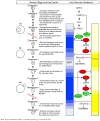Oocyte maturation failure: a syndrome of bad eggs
- PMID: 20378111
- PMCID: PMC2946974
- DOI: 10.1016/j.fertnstert.2010.02.037
Oocyte maturation failure: a syndrome of bad eggs
Abstract
To show that disruption of meiotic competence results in cell cycle arrest, and the production of immature oocytes that are not capable of fertilization. Through an extensive review of animal studies and clinical case reports, we define the syndrome of oocyte maturation failure as a distinct oocyte disorder, present a classification system based on clinical parameters, and discuss the potential molecular origins for the disease.
Copyright © 2010 American Society for Reproductive Medicine. All rights reserved.
Figures

References
-
- Muasher SJ, Abdallah RT, Hubayter ZR. Optimal stimulation protocols for in vitro fertilization. Fertil Steril. 2006;86:267–73. - PubMed
-
- Ebner T, Moser M, Sommergruber M, Tews G. Selection based on morphological assessment of oocytes and embryos at different stages of preimplantation development: a review. Hum Reprod Update. 2003;9:251–62. - PubMed
-
- Bar-Ami S, Zlotkin E, Brandes JM, Itskovitz-Eldor J. Failure of meiotic competence in human oocytes. Biol Reprod. 1994;50:1100–7. - PubMed
Publication types
MeSH terms
Grants and funding
LinkOut - more resources
Full Text Sources
Medical
Research Materials

